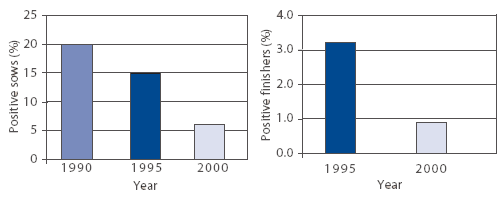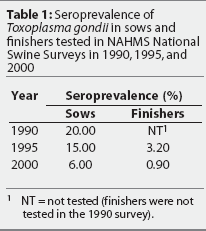What's your interpretation? |
Non refereed |
Toxoplasmosis: Silently declining
Dave Pyburn, DVM
National Trichinae Coordinator and Acting Program Manager, NVAP; USDA, APHIS, VS, 210 Walnut St, Room 891, Des Moines, IA 50309; Tel: 515-284-4122; Fax: 515-284-4191.
Cite as: Pyburn D. Toxoplasmosis: Silently declining. J Swine Health Prod. 2004;12(2):98-99.
 The charts show serological test results from USDA's National Animal Health
Monitoring System National Swine Surveys. Seroprevalence in 1990 is included
for sows but not finishers. Can you speculate on what organism this is and
why the level of seroprevalence is steadily falling in both sows and finishers?
The charts show serological test results from USDA's National Animal Health
Monitoring System National Swine Surveys. Seroprevalence in 1990 is included
for sows but not finishers. Can you speculate on what organism this is and
why the level of seroprevalence is steadily falling in both sows and finishers?
Toxoplasma gondii, a protozoan para- site capable of infecting all mam- mals and birds, is the causative agent of one of the most common parasitic global zoonoses.1 Even though T gondii infections in humans are often asymptomatic, the organism still causes an estimated 112,500 cases of foodborne illness in the United States annually, and together with two other pathogens, accounts for 75% of the foodborne-illness deaths attributable to known agents.2
On the basis of national serologic data collected during the 1994 National Health and Nutritional Examination Survey, approximately 40% of the adult population of the United States has had toxoplasmosis, the disease caused by the parasite T gondii.2 If a woman is infected with T gondii for the first time during pregnancy, spontaneous abortion or infection of the fetus may occur. Infant mortality may be as high as 12%, and 30% of infected infants suffer severe birth defects, including mental retardation.3 The Centers for Disease Control and Prevention estimates that the incidence of congenital infections with T gondii in the United States ranges from 400 to 4000 cases per year. They also estimate that the annual economic impact of toxoplasmosis in humans is $7.7 billion($US).4
Toxoplasmosis may be reactivated in immunosuppressed people, resulting in severe illness and death. Toxoplasmic encephalitis (in which the parasite multiplies in the brain) is the second most common opportunistic infection of the central nervous system related to acquired immunodeficiency syndrome (AIDS). The cost of treating toxoplasmosis in AIDS patients in the United States ranges between $23 and $106 million each year ($US).3
The natural route of T gondii transmission to humans is from animals and contaminated soil and water by way of ingestion. People, other mammals, and birds are usually infected with T gondii in one of three ways: by eating tissue cysts in undercooked meat; by swallowing oocysts (eggs) from cat feces during gardening or other activities involving soil contact; or by ingesting food and water contaminated with oocysts. Cats, and possibly other Felidae, are the only hosts that can shed the environmentally resistant oocysts of T gondii. Animals develop immunity to additional infection as tissue cysts form after infection. These cysts remain alive for the lifetime of the animal, and, in undercooked or uncooked meat, they are infective for animals and humans. Sheep, goats, pigs, chickens, and wild game all may have infective T gondii tissue cysts in edible portions of meat.5
 When T gondii is considered as a
foodborne pathogen, pork is often singled out as
the most likely carrier food. This perception stems from past studies, which
indicate that the seroprevalence of antibodies against
T gondii is high in swine relative to other food-producing
animals.6 The results of the 2000 USDA National
Animal Health Monitoring System's National Swine Survey, the most recent
comprehensive study of the US pork industry, found
a seroprevalence rate of 6.00% for sows and 0.90% for finisher pigs (Table 1) (Dr
E. Bush, Veterinary Epidemiologist and Swine Specialist with the USDA Center for
Animal Health Monitoring, 2002, personal communication). These are both
significantly lower than in previous studies of the
pork industry (Table 1). In 1995, the USDA's National Animal Health Monitoring
System National Swine Survey found rates of 15.00% in sows and 3.20% in
finishers (Table 1).7 In 1990, the same study
tested only sows and found a seroprevalence rate of 20.00% (Table 1) (Dr E. Bush,
2002, personal communication).
When T gondii is considered as a
foodborne pathogen, pork is often singled out as
the most likely carrier food. This perception stems from past studies, which
indicate that the seroprevalence of antibodies against
T gondii is high in swine relative to other food-producing
animals.6 The results of the 2000 USDA National
Animal Health Monitoring System's National Swine Survey, the most recent
comprehensive study of the US pork industry, found
a seroprevalence rate of 6.00% for sows and 0.90% for finisher pigs (Table 1) (Dr
E. Bush, Veterinary Epidemiologist and Swine Specialist with the USDA Center for
Animal Health Monitoring, 2002, personal communication). These are both
significantly lower than in previous studies of the
pork industry (Table 1). In 1995, the USDA's National Animal Health Monitoring
System National Swine Survey found rates of 15.00% in sows and 3.20% in
finishers (Table 1).7 In 1990, the same study
tested only sows and found a seroprevalence rate of 20.00% (Table 1) (Dr E. Bush,
2002, personal communication).
Others still assert that handling raw pork or eating undercooked pork is a major way that people in the United States become infected with T gondii. The Centers for Disease Control and Prevention estimates that 50% of T gondii infections are due to foodborne transmission of the organism.2 Of the food-producing animals, it is believed that swine are more commonly infected and thus more often the foodborne source of the organism.7 Risk factors that have been identified for swine infection with T gondii include lot size, water source, swine contact with cats and cat feces, failure to clean the facility between groups of animals, and a lack of barn-specific boots. The seroprevalence of antibodies against T gondii in US swine has decreased in the last decade, indicating that the infection rate of T gondii in US swine has decreased. This decrease may be due to increased biosecurity in the industry and production practices that separate swine from cats and cat feces.
As a veterinarian, the most effective way you can assist your clients in preventing swine infection with this organism is to advise them on biosecurity and proper rodent control programs. T gondii oocysts are very hardy and may be tracked into facilities on boots, shoes, and clothing. Footwear should be barn specific, ie, when people enter the barn, they put on boots that are worn only within that barn. This will help to avoid bringing T gondii oocysts into the barn. You should also inform your clients that cats do not act as a safe or effective means of rodent control on a farm. Assist your producers with implementing a complete on-farm rodent control program that includes addressing rodent harborage, rodent feed and water, rodent exclusion measures, and rodent population reduction and elimination procedures.
References
1. Tenter AM, Heckeroth AR, Weiss LM. Toxoplasma gondii: from animals to humans. Int J Parasitol. 2000;30:1217-1258.
2. Mead PS, Slutsker L, Dietz V, McCaig LF, Bresee JS, Shapiro C, Griffin PM, Tauxe RV. Food-related illness and death in the United States. Emerg Infect Dis. 1999;5:607-625.
*3. Roberts T, Weiss M, Southard L. Issues in pork safety: Costs, controls, and incentives. Agric Outlook. 1993;201:28-32.
4. Jones JL, Kruszon-Moran D, Wilson M, McQuillan G, Navin T, McAuley JB. Toxoplasma gondii infection in the United States: Seroprevalence and risk factors. Am J Epidemiol. 2001;154:357-365.
5. Dubey JP, Beattie CP. Toxoplasmosis of Animals and Man. Boca Raton, Florida: CRC Press. 1988;220.
*6. Davies P. Foodborne pathogens and pork production: What is our Achilles' heel? Proc AASP. New Orleans, Louisiana. 1999;275-285.
7. Hill D, Dubey JP. Toxoplasma gondii: transmission, diagnosis and prevention. Clin Microbiol Inf Dis. 2002;8:634-640.
* Non-refereed references.
